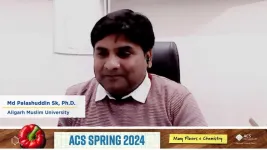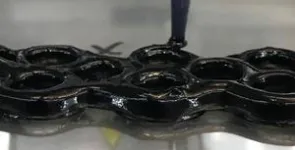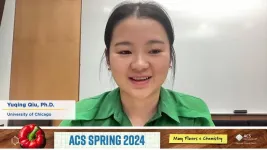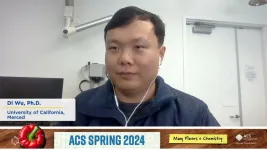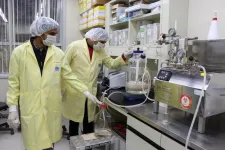The researchers will present their results today at the spring meeting of the American Chemical Society (ACS). ACS Spring 2024 is a hybrid meeting being held virtually and in person March 17-21; it features nearly 12,000 presentations on a range of science topics.
Quantum dots are synthetic nanometer-scale semiconductor crystals that emit light. They are used in applications such as electronics displays and solar cells. “Many conventional quantum dots are toxic, because they’re derived from heavy metals,” explains Md Palashuddin Sk, an assistant professor of chemistry at Aligarh Muslim University in India. “So, we’re working on nonmetallic quantum dots because they’re environmentally friendly and can be used in biological applications.”
Quantum dots are tiny — usually only tens of atoms in diameter. Because they’re so small, their properties are controlled by quantum effects, which makes them act a little strangely compared to larger objects. Namely, they emit light differently than one might expect; for example, gold materials appear blue on this scale. Nonmetallic quantum dots exhibit the same effect and have been explored by other researchers as a tool for bioimaging. Palashuddin has focused on designing carbon- and sulfur-based quantum dots (Cdots and Sdots, respectively) for a variety of other applications.
“Carbon and sulfur are very abundant, cost-effective materials, and they can easily be synthesized into quantum dots,” he says. “You can make carbon dots from waste materials, then use them for removing pollutants — they’re a way to make the process come full circle.”
Palashuddin has already put Cdots and Sdots to work in a variety of ways, though both are relatively recent discoveries. Though small, the dots have a large surface area, which can easily be functionalized to adapt the dots for different applications. Previously, the team designed dots that shined different colors, depending on which contaminants they encountered. That meant they could help identify contaminants — such as lead, cobalt and chromium — in a water sample without leaching any new metals from the dots themselves.
In addition to identifying contaminants, Cdots can help break down pollutants such as pesticides and dyes in water. In one project, Palashuddin and collaborator Amaresh Kumar Sahoo, an assistant professor who studies nanobiotechnology at the Indian Institute of Information Technology, formed Cdots from potato peels and then mounted them on microscopic robots designed to target and degrade toxic dyes in samples simulating polluted water.
The team has also developed methods to remove contaminants from water entirely, rather than just identifying or degrading them. They’ve specially designed Cdots to sop up automotive oil and are currently exploring a Cdot-based filter system to help treat oil spills.
Next, the researchers plan to put their laboratory findings to work in the field, possibly in a project focused on the Yamuna River. This river runs directly through New Delhi and is famously contaminated, especially in more populated areas. Palashuddin hopes to use his team’s nonmetallic dots to identify and separate the various pollutants in the river, including pesticides, surfactants, metal ions, antibiotics and dyes. Ideally, the dots will be functionalized to grab as many of these different contaminants on their surfaces as possible, so they can then be easily removed.
The potential uses for nonmetallic dots don’t just end with water treatment, though. Palashuddin and colleagues are currently investigating uses that could align more closely with traditional, metal-based dots, but without the toxicity concerns. As an example, some light-emitting quantum dots developed by the team could be included in invisible inks to help prevent counterfeiting, or incorporated into light-emitting devices, including television screens.
The team hopes that their work can help broaden the uses for nonmetallic quantum dots and put their unique properties to work in the environment.
The research was funded by the Science and Engineering Research Board and the University Grants Commission of the Government of India.
Visit the ACS Spring 2024 program to learn more about this presentation, “Non-metallic luminescent quantum dots for potential environmental remediation applications,” and more scientific presentations.
###
The American Chemical Society (ACS) is a nonprofit organization chartered by the U.S. Congress. ACS’ mission is to advance the broader chemistry enterprise and its practitioners for the benefit of Earth and all its people. The Society is a global leader in promoting excellence in science education and providing access to chemistry-related information and research through its multiple research solutions, peer-reviewed journals, scientific conferences, eBooks and weekly news periodical Chemical & Engineering News. ACS journals are among the most cited, most trusted and most read within the scientific literature; however, ACS itself does not conduct chemical research. As a leader in scientific information solutions, its CAS division partners with global innovators to accelerate breakthroughs by curating, connecting and analyzing the world’s scientific knowledge. ACS’ main offices are in Washington, D.C., and Columbus, Ohio.
To automatically receive news releases from the American Chemical Society, contact newsroom@acs.org.
Note to journalists: Please report that this research was presented at a meeting of the American Chemical Society. ACS does not conduct research, but publishes and publicizes peer-reviewed scientific studies.
Follow us: X, formerly Twitter | Facebook | LinkedIn | Instagram
Title
Non-metallic luminescent quantum dots for potential environmental remediation applications
Abstract
Non-metallic quantum dots have emerged as a promising paradigm in addressing pressing environmental challenges, outperforming their metallic counterparts. Research endeavors span a comprehensive array of applications, manifesting the multifaceted potential inherent in non-metallic quantum dots. We are developing non-metallic quantum dots like carbon dots (Cdots) and sulfur dots (Sdots) based smart materials for environmental remediation applications. Luminescent Sdots is an emerging metal-free quantum dots. We have reported that Sdots can potentially discriminate colorimetrically and fluorometrically multiple toxic metal ions and separate these metal ions from water. Sdots are found to be low-toxic and suitable candidate for bioimaging. Further, Sdots exhibit antibacterial activity under sunlight. The visible-light-driven photocatalytic properties of Sdots can be used to disinfect the diverse locations of interest.
Concurrently, we explored the superhydrophobic properties of biomass-derived Cdots and unveiled their exceptional capability to selectively separate oil from water in diverse environments, offering a sustainable approach to addressing oil spill contamination. Biomass-derived Cdots are reported as an excellent antibacterial agent, focusing on combating drug-resistant bacterial strains. The findings have underscored their superior antibacterial activity, offering a novel avenue for addressing drug-resistant bacterial infections. Recently, we have developed potato peel-derived autonomous magnetic microbots for the degradation of toxic dyes as well as neurotoxic pesticides. These studies underscore the diverse and promising applications of non-metallic quantum dots in environmental remediation, contributing significantly to the ongoing efforts to address environmental challenges.
END
